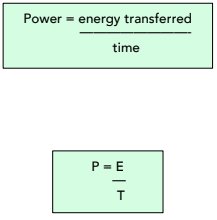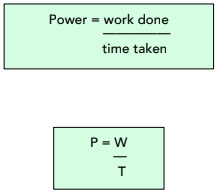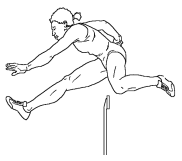Energy - 1.1.4 Power (GCSE Physics AQA)
Power
Power
Rate of Energy Transfer
In previous tutorials we have looked at how we can calculate the energy transferred when work is done. Now we will look at calculating the rate of this energy transfer.
Power is the rate at which energy is transferred. Because work done is the transfer of energy, power also tells us the rate at which work is done.
The unit of power is the watt (W). 1 watt is equal to transferring 1 joule of energy per second. For example, if a lamp had a power of 1W, it means that it transfers 1J of electrical energy into heat and light energy each second.
Calculating Power
We can calculate a value for power using two different formulas. The first involves energy and the second involves work.
1. Energy Transferred

Where:
- Power, P in watts, W
- Energy transferred, E, in Joules, J
- Time, t, in seconds, s
Question: Marianne switches on a toaster for 50 seconds. During this time, the toaster uses 700J of electricity. Calculate the power of the toaster.
1. Write out the appropriate equation.
For this question, the correct equation is:
P = E / t
2. Substitute in the numbers.
We know the values for energy and time taken, so we can simply substitute them in.
P = 700 / 50
P = 14 Watts
2. Work Done

Where:
- power, P, in watts, W
- time, t, in seconds, s
- work done, W, in joules, J
Question: What is the power of a car engine that does 4500J of work in 1.5 minutes?
1. Write out the appropriate equation.
In this situation, the appropriate equation is:
P = W / t
2. Work out the value for time.
In the question, we have been given a value for time in minutes. The equation requires us to give the time in seconds, so we need to convert.
1.5 minutes = 90 seconds
3. Substitute in the numbers.
Now that we have the correct values, we can put the numbers into our equation.
P = 4500 / 90
P = 50 Watts
Question: An athlete of mass 60kg jumps 1.8 metres vertically. The work done in jumping this height was completed in 0.5s.

Calculate the work done and power developed by the athlete.
Work Done = Force x Distance
600N x 1.8m = 1080J
Power = Work Done / Time
1080 / 0.5 = 2160W
Question: Work, energy and power are closely linked. Below are four statements.
- Work done is equal to the useful energy output of a process.
- The higher the power of a system, the more efficient it is.
- A force of 10000N applied through a distance of 5 metres will lead to 50kJ of work being done.
- 1kW means that 1kJ of energy is produced every 1000 seconds.
Which of the statements is / are true?
False. No, some output is wasted.
False. No, a very large system can convert lots of energy but inefficiently.
True. Work done = force x distance, 10,000N x 5m = 50,000J = 50kJ
False. No, 1kJ is produced every second.
Example of Power
Question: Charlotte is comparing 2 electric motors X and Y. Each motor is lifting a mass of 300 grams, to a height of 60cm. This action takes 280 J of work to complete. Motor X lifts the mass in 70 seconds and motor Y takes 40 seconds. Calculate the power of each motor, then state which one is more powerful.
1. Write out the appropriate equation.
In this case, the appropriate equation is:
P = W / t
2. Calculate the power of each motor.
Motor X:
P = 280 / 70
P = 4 Watts
Motor Y:
P = 280 / 40
P = 7 Watts
3. Answer the question.
Now that we have found our two values, we can see that motor Y is more powerful than motor X.
We can link back to our definition for power here. Power is the rate at which energy is transferred or work is done. The faster the rate of transfer, the more powerful the object.






Still got a question? Leave a comment
Leave a comment